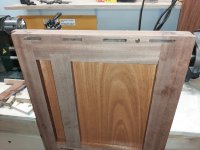smorgasbord
Member
- Joined
- Jan 7, 2022
- Messages
- 1,093
Woodpeckers has a new version of their previous one-time "Ultimate Dowel Jig 2.0" out, called the "Cam-A-Line Dowel Guide"
Honestly, it seems pretty nice, and the video showing its use in creating a table with a recessed apron is also good and no-nonsense. Although I would question the use of ⅜" dowels in ¾" apron stock (but the jig also supports 5/16" and ¼" dowels).
My reason for posting is to, again, discuss dowels versus dominos. The new guide is $240 for the 3 dowel size set. That's obviously a lot cheaper than a Domino machine. So, what's good about the new tool?
1) You can set dowel spacing easily and lock that in so you know they'll match on both sides of the joint
2) There's a fence you can lock in place, again helping alignment
3) They have a clever stop rod system that can be flipped from left to right so that offsets from the edge match up.
Problems?
1) No dust extraction. The video makes a point to show and discuss vacuuming not just after drilling, but after removing the jig from the workpiece.
2) The stop rod system isn't indexed, so once you've readjusted it, as for perhaps a different joint, getting back the exact same distance will require some work, maybe trial cuts.
3) The fence setup isn't indexed, again if you move it then getting it back exactly will require some work/trial. This is interesting, as the previous version of this jig did have 1/32" indexed grooves cut so you could return to the same setting easily. I wonder why they removed that feature.
That said, if you are cost-conscious, or just like dowels, this seems like a nice jig for joinery. It even supports ½" dowels, so some maybe wouldn't need a Domino XL. That said, of course, the domino has other uses as well, but then I suspect this dowel guide could also be used for non-joinery holes, too, like shelf pins, etc.
Good to have choices.
Honestly, it seems pretty nice, and the video showing its use in creating a table with a recessed apron is also good and no-nonsense. Although I would question the use of ⅜" dowels in ¾" apron stock (but the jig also supports 5/16" and ¼" dowels).
My reason for posting is to, again, discuss dowels versus dominos. The new guide is $240 for the 3 dowel size set. That's obviously a lot cheaper than a Domino machine. So, what's good about the new tool?
1) You can set dowel spacing easily and lock that in so you know they'll match on both sides of the joint
2) There's a fence you can lock in place, again helping alignment
3) They have a clever stop rod system that can be flipped from left to right so that offsets from the edge match up.
Problems?
1) No dust extraction. The video makes a point to show and discuss vacuuming not just after drilling, but after removing the jig from the workpiece.
2) The stop rod system isn't indexed, so once you've readjusted it, as for perhaps a different joint, getting back the exact same distance will require some work, maybe trial cuts.
3) The fence setup isn't indexed, again if you move it then getting it back exactly will require some work/trial. This is interesting, as the previous version of this jig did have 1/32" indexed grooves cut so you could return to the same setting easily. I wonder why they removed that feature.
That said, if you are cost-conscious, or just like dowels, this seems like a nice jig for joinery. It even supports ½" dowels, so some maybe wouldn't need a Domino XL. That said, of course, the domino has other uses as well, but then I suspect this dowel guide could also be used for non-joinery holes, too, like shelf pins, etc.
Good to have choices.

